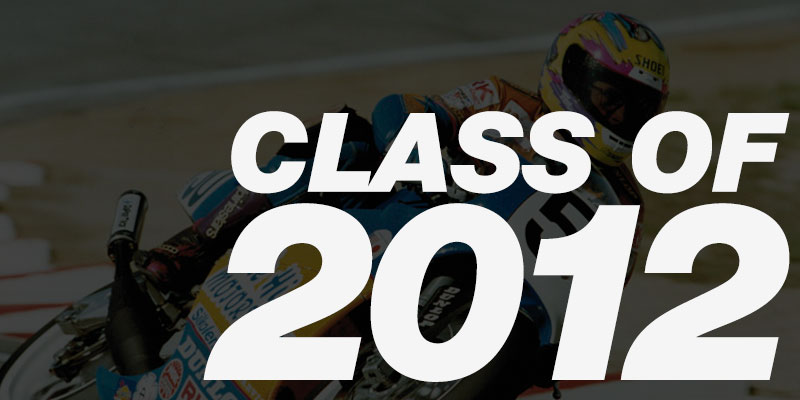
Buddy Lazier
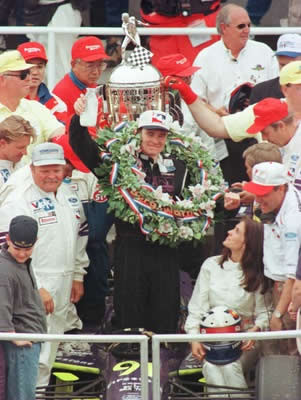 Robert Buddy Lazier was born on October 31, 1967 in Vail. He is the son of Bob Lazier, two-time Indianapolis 500 starter and 2005 Colorado Motorsports Hall of Fame inductee.
Robert Buddy Lazier was born on October 31, 1967 in Vail. He is the son of Bob Lazier, two-time Indianapolis 500 starter and 2005 Colorado Motorsports Hall of Fame inductee.
As a youngster, Buddy was a national-level ski racer from 1972-1987 in slalom and downhill events and was considered an Olympic hopeful. But, he also competed in motocross and karting and chose racing as his preferred sport. He eventually chased success at Indianapolis. His dream was realized when he won the Indy 500 in 1996, eight weeks after suffering a serious back injury. Buddy finished in the top 10 at the Indy 500 six times and had 14 consecutive starts at the Indy 500.
Buddy first appeared in the PPG Indycar Series beginning in 1989 driving for Gary Trout Motorsports and also participated in the Indy 500 as a rookie. In preparation for the founding of the Indy Racing League in 1996, he signed with Ron Hemelgarn’s Hemelgarn Racing, whom he drove for in the Indianapolis 500 in 1991.
This partnership with Hemelgarn resulted in a model IRL season for the team in 2000 with Buddy winning two races on his way to the Indycar series championship, followed by a second place effort in 2001. Hemelgarn racing lost their sponsor following the 2003 season and Buddy only completed in the Indy 500 in 2004 for Hemelgarn. He drove for the Byrd Brothers and Panther Racing in the 2005 Indy 500, placing fifth in the race, ahead of Panther’s two regular drivers, Tomáš Enge and Tomas Scheckter.
In 2005, Buddy acquired a four–race deal with Panther Racing to drive the #95 Pennzoil/American Sentry Guard Dallara/Chevrolet. However, he received an extra race in Enge’s #2 Rockstar Energy Drink Dallara/Chevrolet at Milwaukee on July 24. Enge was injured during a crash at the Nashville Superspeedway during the Firestone Indy 200 a week earlier. He logged four top-10s in the No. 95 and an 18th-place finish in Enge’s No. 2 car.
In 2006, he raced in seven events for Dreyer & Reinbold with a best finish of 12th in the Indy 500. Buddy then teamed up with Sam Schmidt Motorsports to race in the 2007 Indianapolis 500. Buddy and Hemelgarn Racing reunited for the 2008 Indy 500, Buddy’s last run at Indy.
Away from racing, Buddy continues to enjoy skiing, along with boating, soccer, mountain climbing, motocross, water skiing, and spending time with his wife and children.
Donnie Hough
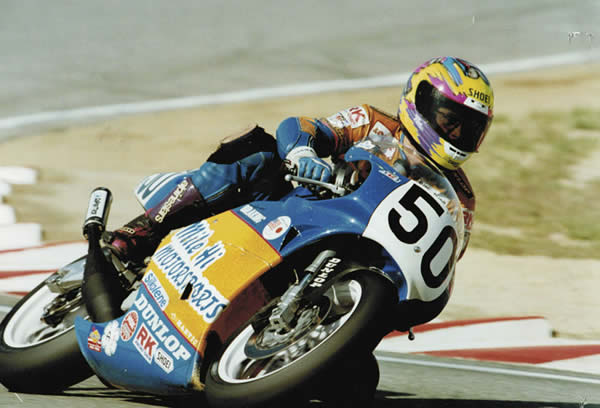 Donnie Hough began riding motorcycles at the age of seven. His father owned a Yamaha dealership in Boulder, Colorado and it was a natural progression to begin riding. Beginning in 1971, he rode JT-1 Yamaha mini enduros at Coal Creek Raceway. In the early 1980’s, he began racing flat track on a TT 500 Yamaha motor in a Track Master frame. He was very competitive, racing all over Colorado against the likes of Danny Walker, Bruce Sass and many other fast flat trackers.
Donnie Hough began riding motorcycles at the age of seven. His father owned a Yamaha dealership in Boulder, Colorado and it was a natural progression to begin riding. Beginning in 1971, he rode JT-1 Yamaha mini enduros at Coal Creek Raceway. In the early 1980’s, he began racing flat track on a TT 500 Yamaha motor in a Track Master frame. He was very competitive, racing all over Colorado against the likes of Danny Walker, Bruce Sass and many other fast flat trackers.
In 1985, he became interested in motorcycle road racing. In his first race, Donnie finished second in the last race of the Mountain Roadracing Association season at Second Creek Raceway. In 1986, he raced the entire MRA season. He would have finished in the top 10 in season points had it not been because he was required to race the first several race as a “novice,” and not allowed to count the points towards the “expert” class points championship.
He finished the 1987 season in the top 10 in final standings in Open Superbike and 600 Superbike, and top five in Formula 1. He scored top 10 results in Open Superbike, 750 Superbike and Race of the Rockies events in 1988, and won the 1989 Formula Colorado Class Championship in modified dirt bike competition.
Donnie got his first true Superbike ride at the end of 1990 on a FZR 1000 and finished in the top five in the last race of the year at Second Creek Raceway.
In 1991, he won the MRA Open Superbike Championship, and in 1992 he notched his first Race of the Rockies Championship, as well as another MRA Open Superbike Championship. He repeated as Race of the Rockies Champion and MRA Open Superbike Champion again in 1993. Donnie went AMA 250cc National racing in 1994, running as high as 3rd in the U.S. before a bad crash at Laguna Seca. At the end of the 1994 season, he was invited to compete on the European 250 GP circuit. Though his results were not stellar, he got the experience of a lifetime.
Back in MRA competition in 1995, he finished third in a combined Race of the Rockies class. In 1996, not only did he win every Race of the Rockies 10 race series, something never before accomplished, he also set, and held, lap records at all of the MRA tracks. After the MRA season, he went to Daytona and proceeded to win two national championships in the AMA CCS Race of Champions, beating many factory riders.
He then won the 1997 MRA Middleweight Supersport Championship and finished eighth overall in the Race of the Rockies.
Since 1997, he has not competed in an entire season; however, he finished fifth at the 2001 AMA 250cc national event at Pikes Peak International Raceway. He also raced to a second place standing in the MRA 2006 Race of the Rockies GTU series.
Jack Richards
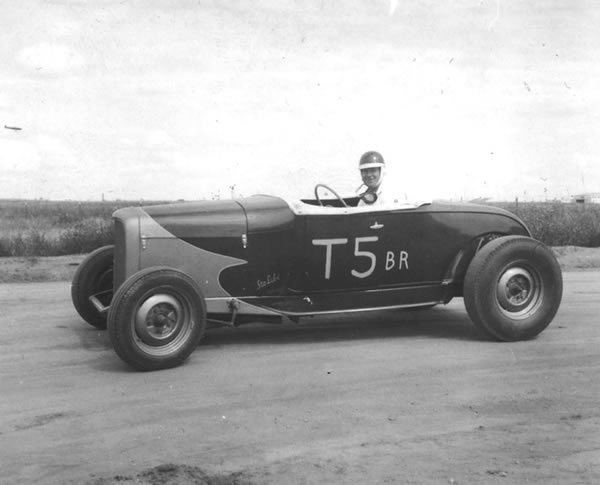 Jack Richards was born in Denver on August 8, 1921. After graduating from high school in 1939, he moved to Los Angeles, California, where he got a job at McDonnell Douglas installing instruments in DC-3’s. There he purchased a ’29 Model A body and frame and a ’31 Auburn dash and started his roadster. He remained there until the end of the war.
Jack Richards was born in Denver on August 8, 1921. After graduating from high school in 1939, he moved to Los Angeles, California, where he got a job at McDonnell Douglas installing instruments in DC-3’s. There he purchased a ’29 Model A body and frame and a ’31 Auburn dash and started his roadster. He remained there until the end of the war.
He returned to Colorado in 1946 and discovered another love – motorcycles. Jack became one of Colorado’s racing pioneers with both his roadster and his Harley “74”.
He was a charter member of the Denver Timing Association in 1949. Jack raced on dirt circle tracks at DuPont, and at South Table Mountain in Golden, and on dirt dragstrips in Colo. Springs and Pueblo. He ran top speed races on an asphalt road south of Centennial Race Track and dragstrips in Cheyenne, Wyoming, Julesburg, Colo., Scottsbluff, Neb., and Garden City, Kansas.
Jack won the inaugural Georgetown Hill Climb and drove the only hot rod to beat the sports cars in the Lookout Mountain Hill Climb. He participated in countless motorcycle hill climbs, endurance runs and TT races, bringing home many trophies.
He competed in the 2nd annual Bonneville Nationals in 1950, and raced there through 1955 with a fuel burning flathead which was the fastest flathead in his class in 1955.
At Lowery Air Force base on May 31, 1954, Jack became the first person in Colorado to exceed 100 mph in the ¼ mile in a roadster. He was the 3rd person overall, following only the Kenz & Leslie dragster and a fuel burning motorcycle.
He raced at the first NHRA Nationals in Great Bend, Kansas in 1955 and had low ET in his class. Bill Kenz and Roy Leslie asked Jack to be a crew member with their streamliner at Bonneville. As such, he helped tune the three flatheads to a record of 272 mph in 1957.
His roadster was back at the Salt Flats in 1958 with a 347ci Pontiac. Having only a mild Isky cam and 6 Stromberg 97’s, Richards ran 151 mph.
Jack was asked by the staff at CDR to help run the drag races when it opened in 1959. He classified the hot cars and motorcycles in the mornings and in the afternoon ran the street eliminator bracket. He carried out those responsibilities until 1972 when CDR closed.
Jack built another ’29 roadster for Bonneville with a blown 302ci Chrysler. In 1966, he set a record in B/Gas Roadster of 183 mph. The same engine was used in his Bantam bodied altered roadster, which ran both fuel & gas at CDR, Rocky Mountain and Bandimere. In 1965, Jack and four of his friends were among the first to put their Hot Rods on the street in Denver. They were the charter members of the Denver Roadsters.
In 1981, Jack joined the Early Ford V8 Club, and joined the Flatheaders in 1991. He was also a charter member of the National Street Rod Association (1972). Jack was one of the best in Colorado when it came to building and making a flathead run. He was one of the few people to gain the full confidence of Bill Kenz and Roy Leslie. He also helped many other drag racers in the Denver area build and tune their Ford flatheads, and was still helping drag racers at Bandimere Speedway until he passed away in 2001.
Jimmy LaManna, Sr.
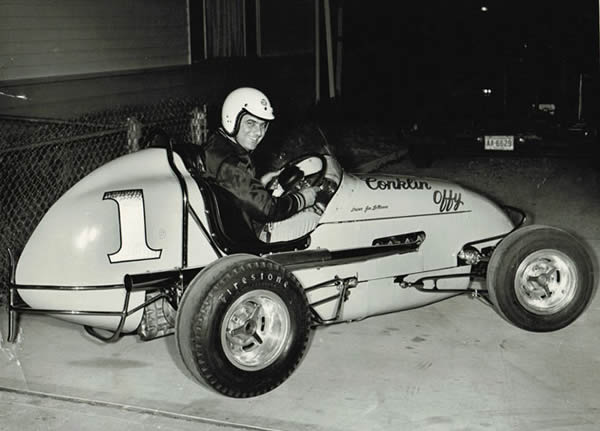 Jimmy LaManna, Sr. was born in Denver in 1932. He attended Cathedral High School. His love affair with racing began at 45th and Pecos in North Denver. There, he lived around the corner from Ralph Icovetta. Ralph had a roadsters race shop there, and Jimmy stated hanging around. Then, Ralph took Jim to Lakeside Speedway and Jim was hooked. With the help of friends, he built his first car in 1950 and began racing. He was too young to drive, so he took the name of Herkimer Snead. In 1951, he was leading the points in stock cars when his aunt recognized him and told his dad. His dad parked him for the last two races. He ended up finishing second in championship points.
Jimmy LaManna, Sr. was born in Denver in 1932. He attended Cathedral High School. His love affair with racing began at 45th and Pecos in North Denver. There, he lived around the corner from Ralph Icovetta. Ralph had a roadsters race shop there, and Jimmy stated hanging around. Then, Ralph took Jim to Lakeside Speedway and Jim was hooked. With the help of friends, he built his first car in 1950 and began racing. He was too young to drive, so he took the name of Herkimer Snead. In 1951, he was leading the points in stock cars when his aunt recognized him and told his dad. His dad parked him for the last two races. He ended up finishing second in championship points.
Jimmy ran 1952 and 1953 at Englewood, driving Burt Blanoy’s 1934 Ford #50. He was again in contention to win the championship in 1952 when he was disqualified due to his age. In 1954 and 1955, he tried his hand at three-quarter midgets. Jimmy then met Ade Butler, who owned a V8-60 midget. He then drove for Ade from 1957-1960. In 1960, Jimmy finished second to Eddie Jackson in the championship, winning three features that season.
In 1961, Jimmy and Sam Rodriguez got together and ran the #27 Offenhauser. That year, Jim had 10 feature wins, plus the Rocky Mountain Midget Racing Association Championship. He finished third in points in 1962 with Rodriguez. Jimmy also broke Roy Bowe’s long standing one-lap record at Lakeside during that year.
Jimmy won his second RMMRA title driving for Harry Conklin in 1964 and 1965. In 1966, with six feature wins under his belt, Jimmy was badly burned in a racing incident. He spent three and one-half months in the hospital – ending his racing career. During his career he set several records along the way, including three championships.
He and his wife, Theresa, had two children, Jim Jr. and Lesley, five grandchildren and three great-grandchildren. In addition to racing, Jimmy also had a 39-year career at Western Paving.
Jimmy passed away in 2006.
Judd Pickup
 Judd was born in Wiggins, Colo. in 1915. He began midget racing at Merchant Park in 1937 under the assumed name of “Kid Wilson” so his parents wouldn’t find out he was involved in such a dangerous sport. His first midget was an Elto 4-60 outboard he bought from Walt Killinger for about $500. He won a main event during his first season racing. He then began racing in a midget owned by George and Jack Speak, after their driver, Vic Felt, was injured. During the 1938 season while racing at Lakeside Speedway, he made midget racing history. During that season, he recorded an amazing nine wins in a row, won 15 out of 17 races and claimed the 1938 Colorado Midget Racing Championship. He also set the Lakeside Speedway track record of 15 seconds. He continued to race through the beginning of the 1939 season and then turned the machine over to Lloyd Axel. Axel won five features in it, finishing fifth in Denver’s American Automobile Association points. Judd then sold the car to help finance his education at the University of California, Berkeley. In addition to racing, he also served in the Navy during World War II and worked for the Champion Spark Plug Company until his retirement at age 65.
Judd was born in Wiggins, Colo. in 1915. He began midget racing at Merchant Park in 1937 under the assumed name of “Kid Wilson” so his parents wouldn’t find out he was involved in such a dangerous sport. His first midget was an Elto 4-60 outboard he bought from Walt Killinger for about $500. He won a main event during his first season racing. He then began racing in a midget owned by George and Jack Speak, after their driver, Vic Felt, was injured. During the 1938 season while racing at Lakeside Speedway, he made midget racing history. During that season, he recorded an amazing nine wins in a row, won 15 out of 17 races and claimed the 1938 Colorado Midget Racing Championship. He also set the Lakeside Speedway track record of 15 seconds. He continued to race through the beginning of the 1939 season and then turned the machine over to Lloyd Axel. Axel won five features in it, finishing fifth in Denver’s American Automobile Association points. Judd then sold the car to help finance his education at the University of California, Berkeley. In addition to racing, he also served in the Navy during World War II and worked for the Champion Spark Plug Company until his retirement at age 65.
Judd passed away in 2009.
Mike Bonicelli
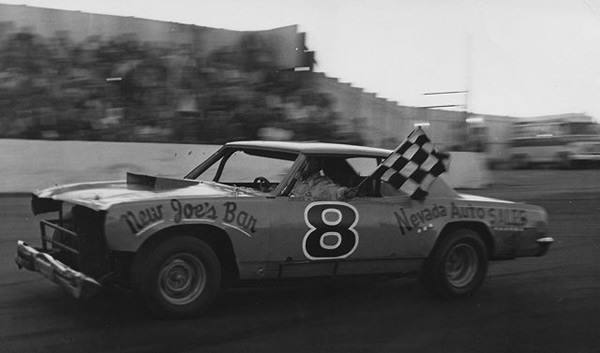 Mike Bonicelli began racing at age 18, when he built a drag car and raced it locally in Colorado. However, his dream was to race ovals, so before his 20th birthday he switched to local stock car racing.
Mike Bonicelli began racing at age 18, when he built a drag car and raced it locally in Colorado. However, his dream was to race ovals, so before his 20th birthday he switched to local stock car racing.
Mike began racing at Pikes Peak Speedway in 1971 and was very successful in the late model stock car class. He had many “fast times” and won a number of main events. He then went on to race at Colorado Springs International Speedway, which he and his dad built east of Colorado Springs in 1976. They contacted NASCAR for sanctioning and their track became the first short track in Colorado to have NASCAR sanctioned events. This was the beginning of the Winston Racing Series in Colorado and Mike was the NASCAR Winston Racing Series Champion in 1978.
During his years of racing in Colorado Springs, Mike was an active member of the Pikes Peak Stock Car Racing Association, and over the years he held many positions as an officer and also as chairman of the board.
Mike continued to run at CSIS but he wanted to advance again and began racing at Colorado National Speedway in Erie, Colo. against Denver-area competitors. He also ran short track “open competitions” in Colorado, Nebraska, Utah, Nevada, Arizona, Texas, California, and Washington. They were very successful, winning many “open competitions,” holding track records, and having a winning record of over 100 wins on short tracks. Mike’s pink number 8 Camaro was featured on the cover of Circle Track Magazine during this time, which was a great honor to Mike and his team.
The fame of the Pikes Peak Hill Climb pulled at Mike and he drove up “the hill” twice. He finished the first time on two flat tires and during the second race he rolled the race car at the picnic grounds in an effort to miss some spectators that were standing hand-in-hand across the race course.
In 1980, Mike drove a Grand National car owned by Chuck Williamson of Seaside, California at Phoenix International Raceway. Mike was running third in the race when an unscheduled pit stop dropped him to a ninth place finish, but finishing in the top 10 in his first NASCAR Grand National Race spurred him on to want more.
The team then put together a car for the NASCAR Grand National Series in the Southeast. After running a limited schedule in the Grand National Series for a couple of years, Mike found he could not breathe well enough for the longer races due to acute asthma. He knew that his driving career was going to have to end soon, and although he was a very successful driver, he would step back to ownership and hire drivers for his team. In the last few years of Mike’s team ownership, they finished second in the SouthWest Tour, and had the “Rookie of the Year” in the Southwest Tour.
Mike finally decided to sell his cars and equipment in 2003. However, he continues to help young racers in his area to see if they have what it takes to go “big time,” and counsels them on the hard road to get there.
Richard Burton
 After spending many years attending races at Englewood Speedway and Lakeside Speedway, Richard Burton’s racing career began in figure eight and demolition derby racing when he built his first cars in 1969. In addition to winning many demo derbies in his early years, he also won two Figure Eight Season Championships in 1977 and 1978. His 1978 season featured 14 main event wins in a row, and 16 out of 20 main event wins overall. He also won the 1978 championship by a 1,100 point margin.
After spending many years attending races at Englewood Speedway and Lakeside Speedway, Richard Burton’s racing career began in figure eight and demolition derby racing when he built his first cars in 1969. In addition to winning many demo derbies in his early years, he also won two Figure Eight Season Championships in 1977 and 1978. His 1978 season featured 14 main event wins in a row, and 16 out of 20 main event wins overall. He also won the 1978 championship by a 1,100 point margin.
In 1978 and 1979, Richard and his grandfather, Harold Brady “76,” both won major awards from the Colorado Motorsports Hall of Fame. The awards were given to Richard for “Top Oval Track Driver” and Harold Brady for “Mechanic of the Year.”
When Englewood Speedway closed, Richard made the move to Lakeside Speedway where he again handily won a Street Stock Track Championship. He was then asked to drive for Wes Padgett and Big Bill Johnson in the sportsman cars at Lakeside Speedway and Colorado Springs International Speedway. After running a season at Colorado National Speedway on the dirt, he returned to compete at Colorado Springs International Speedway, driving his own limited late model. During that season he also ran at I-80 Speedway in Greenwood, Neb. and at Big Country Speedway in Cheyenne, Wyo.
He returned to race at Colorado National Speedway when it was paved in 1989. He ran in the Sportsman Division in a Don Wilson built chassis. After finishing in the top five two straight years, he got his third track championship in 1993. Richard also drove a Grand American Modified for Darrell Smith where he finished in the top six. He continued to run at that track and in 1994, he moved to the Late Model Division. He was selected “Sportsman of the Year” from 1995 to 1997. In 1999, driving for Jim Newland and Tony Unrien, he won the “Challenge Cup” in the Late Model Division and the coveted Late Model Championship. He then moved to the Truck Division, driving for owners Alan Carter and John Shaw. In 2006, while driving his own truck, he won his sixth track championship. He continued to race in the Truck Division where he was battling for another championship, but his season ended before the final week of the 2009 season.
On September 9, 2009, Richard was seriously injured when he was struck by lightning. After several months of rehabilitation, he battled his way back and returned to the track in time to watch and spot for his grandson, Matthew, who competes in the truck Richard was driving. Richard wants to return back behind the wheel, but if he cannot, he will continue to be a part of automobile racing in some capacity.
In Richard’s 40 years in racing, he has won 6 track championships, recorded 31 top 10s and 23 top fives, and had 31 perfect attendance seasons. In over 700 main event starts, Richard has recorded more than 130 main event wins.
Richard has also run in several NASCAR Touring Division races, and he also participated in the World Figure Eight Championships in Islip, NY and in Saugus, Calif.
Richard has driven for some great owners, including Jim Newland, Tony Unrien, Alan Carter, John Shaw, Darrell Smith and Larry Craver. He has had the opportunity to crew for some of the best, including Rick Carelli, Don Wilson, Roger Avants, Kevin Clark, and Chris Eggleston, among others. His crews have been mostly family members including his wife of 41 years, three children, grandchildren and very close friends. Two of his crew members won the True Value Gold Wrench Award.
Richard’s proudest moments have been being a part of the Englewood Speed Pledge program to make our streets safer. He did this along with Roger Avants, Roger Mitchell and Nancy Peterson. This has included school visits and many hospitals trips to visit sick and hurting children. His goal was to make them smile and give them and their families hope. This is more important to him than any achievements possible on any race track.
Roger Avants
 Thanks to his father, Walt Avants, Roger Avants got the racing bug more than 40 years ago. Roger started out racing in the Figure Eight Division at Englewood Speedway along with his brother, Larry, who raced in the Sportsman Division. It was here that Roger mastered car control. After racing five years in figure eights, Roger moved up to the Late Model Division, much to his mother’s dismay. She wanted him to win a championship in figure eights before moving up to late models.
Thanks to his father, Walt Avants, Roger Avants got the racing bug more than 40 years ago. Roger started out racing in the Figure Eight Division at Englewood Speedway along with his brother, Larry, who raced in the Sportsman Division. It was here that Roger mastered car control. After racing five years in figure eights, Roger moved up to the Late Model Division, much to his mother’s dismay. She wanted him to win a championship in figure eights before moving up to late models.
After Englewood Speedway closed in 1979, Roger ran late models regionally. He won the championship at Colorado Springs International Speedway in 1981 and was also very successful outside Colorado, winning many races in Texas and Oklahoma. In 1986 the NASCAR Southwest Touring Series began. Roger won the inaugural Southwest Tour Race at Saugus Speedway in California.
After a couple of years on the road, Roger came home to race when Colorado National Speedway was paved in 1989. He won his first championship at CNS in 1990 followed by track championships in 1992, 1993, and 1995. During those years, Roger also ran ASA and Midwest Series. In 2002, not only did Roger win the championship at CNS, but he also won the NASCAR Weekly Racing Series Northwest Region Championship. This is one of the biggest accomplishments of his career and one in which he is most proud.
In 2011, Roger won his most recent championship in the Pro Trucks Division at Colorado National Speedway where he is still competing weekly in both the Late Model Division and Pro Truck Division.
Roger has driven for many car owners all across the country throughout his racing career, and they are as follows: Walt Avants, Ed Brunner, Mark Tunstead, Jerry Malloy, Alan Beebee, Darrel Smith, Dick Hoffman, Don Wilson, Mike Leary, Don Smith, Mark Vidger, Gary Young, Dave Napier and Alex Ortiz. One of the awards Roger is very proud of is the fan voted “Most Popular Driver Award” which he won five years in a row at Colorado National Speedway. He has been awarded “Overall Sportsman of the Year” a couple of times as well.
For Roger, racing is not only about the competition, but it is also about the people and it is a way for him to give back to the community. He was a part of the Missing Children’s Task force and has the honor of having the most “found kids” of all of the drivers who posted pictures of missing children on their cars. He also had the privilege of meeting some of the kids after they were found! He participated in the Englewood Speed Pledge Program promoting safe driving on the city streets.
Not only is Roger a fierce competitor, he is also a mentor to many of the drivers and now has the opportunity to share his knowledge through his job at Leary Racing Products.
Sam Rodriguez
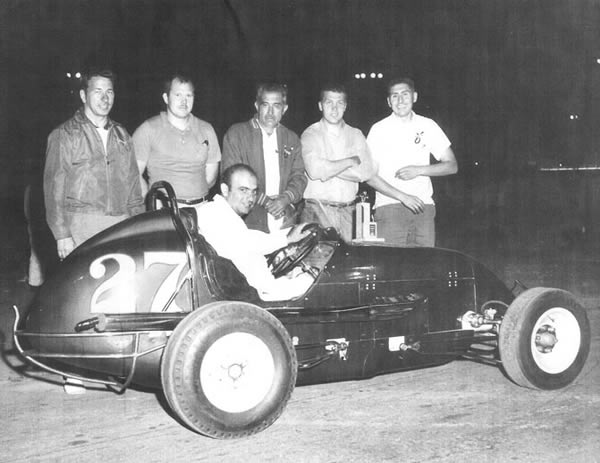 Sam Rodriguez was born in Hayden, Colo., in 1933. Following his release from active duty in the Marines, he attended Denver University. He attended his first midget race at Lakeside Speedway in 1947.
Sam Rodriguez was born in Hayden, Colo., in 1933. Following his release from active duty in the Marines, he attended Denver University. He attended his first midget race at Lakeside Speedway in 1947.
Sam purchased his first race car, a V8-60, from Dick Kendrick, in 1955. He was befriended by Lloyd Axel, Buddy Shay and Keith Andrews. They became his mentors as well has his good friends. Sam had numerous drivers in 1955, including Tommy Rice, Bert McNeese, Brad Bradford, Bob Courtney and Joe Alspach.
In 1956, Sam had Keith Andrews, Charlie Louderman and McNeese in the car. In 1956, Sam was also on the pit crew for Andrews when he finished 26th at the Indianapolis 500, driving the Dunn Engineering car #89.
Sam is pictured on the far right.
In 1957, Sam purchased a Kurtis Offenhauser and when he was car owner and chief mechanic, the car set a number of track records throughout the Midwest. In 1958 he then put Warren Scheibe in the cockpit. Sam and Warren finished ninth in the Rocky Mountain Midget Racing Association point standings in 1958. The next year Sam returned to Indy as a pit crew member on the Radsco Battery Special.
Jimmy LaManna, Sr. took over as Sam’s new driver in 1960, and in 1961 they set seven fast times at Lakeside and compiled four trophy dash wins, 13 heat race wins, four main event wins and won the Molly Mayfield Foundation Benefit main event. As a result, Sam as owner/chief mechanic won the RMMRA Championship.
In 1962 Jim LaManna, Sr. remained as driver and once again the car set seven fast times, and recorded three trophy dash wins, three heat race wins, one semi main win and two main event wins. Unfortunately, the car was badly damaged in a spectacular flip at Lakeside Speedway and they ended up finishing third in championship points.
Sam continued owning cars through the early 1970s. Since retiring, he has restored three Model A’s to museum quality, built a midget roadster with his good friend Ody Fellows, assisted with two Edmund midgets and has worked on numerous other cars.
Sam persevered throughout life, working his way through college, the USMC, and working his way up in the meat packing business from cleaning the kill floor to becoming owner of his own company. He often worked two jobs to support his racing dreams and became the first Hispanic owner/mechanic to win a RMMRA Championship.
Ron Leslie
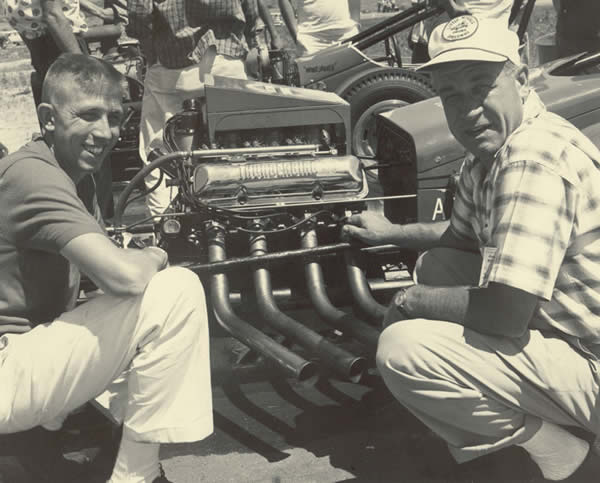 Ron was born into a family that was already into high performance vehicles. So it was only natural to follow the lead. As early as six months old, he was in the grandstands at Merchants Park and later Lakeside Speedway.
Ron was born into a family that was already into high performance vehicles. So it was only natural to follow the lead. As early as six months old, he was in the grandstands at Merchants Park and later Lakeside Speedway.
With his father, Roy Leslie, having won two Rocky Mountain Midget Racing Association Championships by the time he was six years old, young Ron became very enthusiastic about open wheel racing.
Ron’s first racing experience came in 1951, when he entered the Soap Box Derby, and finishing as the runner up. At age 16, Ron’s first car was a 1939 Ford Deluxe Coupe with a 276 flathead, which he ran at Lowry drags in’54 and ’55 in C-Gas class. In 1955, he got his ride in the K&L Roadster with a Lincoln engine for power. His first pass was over 107 MPH. From that time forward, he campaigned the roadster locally.
Ron is pictured on the left.
Ron was also involved in the formation and acquisition of Jeffco Fair Grounds for the quarter midget racing that ran there from 1957 through 2000.
In 1959, Ron purchased a Scotty Fenn TE440 chassis using a carbureted 390 Ford engine. While Ron was on active duty in the army, Bill Kenz built a front cover and blower adapter so that the 390 was fitted with a supercharger for the 1960 season. From this time on Ron was behind the wheel of the Kenz and Leslie drag car entries.
In 1965, Kenz and Leslie purchased a Woody Gilmore Flex dragster into which a blown 427 Ford engine was installed. It made its debut in May of 1965.
The 1967 season saw the Kenz and Leslie fuel dragster fitted with a Single Over Head Cam Ford motor, one of only a few throughout the country.
1965 was the year that the Funny Car craze hit. Late in the year, K&L was notified by the Mercury Performance Program that they would be receiving one of four Mercury Comets being built for their new race program. In 1966, with the new Comet, they qualified in the number one spot for the NHRA World Finals. Unfortunately the event did not turn out well as Ron flipped the car and totally destroyed it. But the Funny Car program was not over. 1967 saw the team return with a Mercury Cyclone funny car. From 1966 through 1971 a number of funny cars ran under the Kenz and Leslie banner. K&L’s 1968 High Country Cougar set a NHRA nation speed record, becoming ‘The Worlds Fastest Cougar.’ The last of the funny cars was the High Country Comet powered by a Single Over Head Cam Ford Engine in a Gilmore chassis. The Kenz and Leslie race cars were always finely prepared.
Ron was involved in numerous match-races in both the dragster and funny car classes throughout his racing career. Two of his most memorable races were defeating The Ram Charger and Don Nicholson, both nationally known stars in the Funny Car ranks, with three straight wins in the best of three series. His racing career came to a close in 1971. Ron Leslie passed away March 28, 2017
Scott Stocker
The board selected veteran motorsports journalist Scott Stocker to be the recipient of the 2012 Jerry Van Dyke Memorial Award, recognizing outstanding contribution to motorsports by an individual.
As a journalist, Scott has received numerous awards for his outstanding work, including being named the 1998 NHRA, Division V, “Mogul Writer of the Year” and being elected in 2004 to the Colorado High School Activities Association Hall of Fame.
Scott is currently a sports reporter for the Metro North News, Max Preps, Colorado Sports Insider/Preps and other publications. From 1986 to 2009, he was a sports columnist and reporter for the Rocky Mountain News. It is during this time that Scott earned a reputation for being one of the top motorsports reporters in the state. As such, he worked hard to promote all angles of the sport and brought significant statewide publicity to Colorado motorsports.
From 1972 to 1986, he was a contributor to Denver Post, Rocky Mountain News, AP News Services, UPI News Services and various in-state publications.
In addition to his journalism background, he has worked in the medical field, both for the US Army and the private side. He also served as a basketball official. He received his BA in education and history from the University of Colorado.
